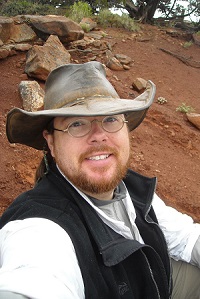Assistant Scientist
College of Letters & Science | UW Geology Museum
Dave Lovelace is a vertebrate paleontologist specializing in Triassic-aged rocks of the Rocky Mountain West (252-201 million years ago). He joined the UW Geology Museum team as a research scientist after completing his PhD at UW-Madison’s Department of Geoscience in 2012. Dave combines the study of ancient bones, trackways, and soils to build a picture of what ecosystems looked like 230 million years ago — when the first mammals, turtles, crocodiles, lizards, dinosaurs, and birds evolved. Since becoming a member of the museum team, Dave had made several exciting discoveries including: the oldest known turtle tracks in the world, two mass-death-assemblages of Late Triassic amphibians, and the oldest dinosaur tracks in Wyoming.
Testimonials
Your presentation was excellent. You did such a good job relaying a rather complex subject to a bunch laymen…. You are certainly an expert in your field of expertise and also bird anatomy. – Kevin D., Lakeland Audubon Society
Talks:
State of the Art: The Science Behind Vertebrate Paleontology's Visual Evolution
How has our perception of dinosaurs changed in the last 175 years since their first recognition in the fossil record? A journey through dinosaur art and science.
Approximate Length of Talk: 45 minutes – 1 hour
Modeling Dragons: Niche Partitioning in Komodo vs. Two Triassic Dinosaurs
Stories in Stone: The Life Histories of Dinosaurs
One of the most fascinating things about the geological record is the preservation of our planets history. It is a history that can be told from many different perspectives at many different scales ranging from the preservation of raindrops to dynamic times of great calamities, continental upheavals, and biological revolutions. One such revolution occurred nearly 230 million years ago when dinosaurs arose from a group of small agile upright reptiles. This revolution was so successful that dinosaurs dominated terrestrial ecosystems for nearly 170 million years, just as they dominate the air today. Each new dinosaur locality holds a vast array of information that lends insight into the lives of these fantastical creatures, from the preservation of soft tissue to how they lived, breathed, and died. This talk will take us on a journey through time as we read these long-forgotten stories in stone.
Hidden Biodiversity: Ancient Tracks and Traces
North America’s Oldest Winged Dinosaur: The Evolution of Avian Flight
The turn of the century saw a new revolution in our understanding of dinosaur evolution and their relationship with modern birds. Hundreds of new specimens, mostly from Asia, have illuminated a surprisingly diverse array of winged (paravian) non-flying feathered dinosaurs. In 2004 an accidental discovery of a tiny meat eating theropod dinosaur started a 15 year project for three undergraduates from the University of Wyoming, two of whom moved to WI to pursue a their doctorate, bringing the project with them. This little dinosaur has been known as ‘Lori’ for many years, and as of July, 2019 was formally named Hesperornithoides miessleri.
miessleri is the oldest known paravian from North America. This study not only includes the description of this animal, but the analysis of its evolutionary relationship within the dinosaur family tree, and has led to novel observations that show the long drawn out history of avian flight evolution. A majority of evolutionary branches on the paravian limb, including the well known Archaeopteryx, Troodon, and Velociraptor; each belongs to a lineage that began with long armed, winged feathered dinosaurs without the ability to fly. Interestingly, each of these lineages, in parallel, later evolved some degree of aerial capability, if not outright flight. However, the true ancestors of birds are on yet another branch of the paravian limb. This drawn out history is unlike that seen in other flying vertebrates such as bats and pterosaurs, whose flight capabilities evolved much faster. This is a compelling story of how science works, and the evolution of our understanding of avian flight.
Approximate Length of Talk: 45 minutes – 1 hour
Videos:
A/V and Set-Up Needs:
